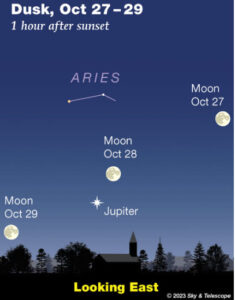Special to CosmicTribune.com, October 22, 2023
Excerpts from weekly Sky&Telescope report.
SATURDAY, OCTOBER 21
■ First-quarter Moon (exact at 11:29 p.m. EDT).
■ The shadow of Jupiter’s fast-moving moon Io crosses onto the eastern edge of Jupiter’s face at 8:07 p.m. EDT, followed closely by Io itself 20 minutes later. Jupiter’s Red Spot should transit the planet’s central meridian later in the night, around 12:30 a.m. EDT.

■ The Orionid meteor shower should be near its peak late tonight. The good Orionid-watching hours are from about 1 a.m. to the first light of dawn.
SUNDAY, OCTOBER 22
■ This is the time of year when the Big Dipper lies down horizontal low in the north-northwest after dark.
MONDAY, OCTOBER 23
■ The Moon, a little past first quarter, is at one of its most entrancing telescopic phases: the sunrise terminator crosses Mare Imbrium with its dramatic contrasts of flat plain and shadow-casting mountains and crater walls. And this evening and tomorrow evening the Moon accompanies Saturn with its dramatic rings and pinpoint telescopic moons.
TUESDAY, OCTOBER 24
■ Look for bright Capella sparkling low in the northeast these evenings. Look for the Pleiades cluster about three fists at arm’s length to its right. These harbingers of the cold months rise higher as evening grows late. Upper right of Capella, and upper left of the Pleiades, the stars of Perseus lie astride the Milky Way.
WEDNESDAY, OCTOBER 25
■ The Ghost of Summer Suns. Halloween is approaching, and this means that Arcturus, the star sparkling low in the west-northwest in twilight, has become “the Ghost of Summer Suns.” What does this mean? For several days centered on October 25th every year, Arcturus occupies a special place above your local landscape. It closely marks the spot where the Sun stood at the same time, by the clock, during hot June and July — in broad daylight, of course! So at Halloween season every year, you can see Arcturus as the chilly ghost of the departed summer Sun.
FRIDAY, OCTOBER 27
■ The Summer Triangle Effect. Here it is nearly the end of October, but Deneb still shines near the zenith as the stars come out. And brighter Vega is still not far from the zenith, toward the west. And the third star of the “Summer” Triangle, Altair, remains very high in the southwest.
SATURDAY, OCTOBER 28
■ Full Moon (exact at 4:24 p.m. EDT). The Moon rises at sunset. As twilight deepens and the Moon climbs higher, there will be Jupiter shining just 3° or so below or lower left of it.
■ A very slight partial lunar eclipse occurs while the Moon is visible from Europe, Africa, and Asia. The partial eclipse will be deepest at 20:14 Universal Time October 28, when just 13% of the Moon’s diameter will be shaded in the umbra of Earth’s shadow. The entire partial eclipse runs from 19:34 to 20:54 UT.
SUNDAY, OCTOBER 29
■ Around the time when twilight fades out, zero-magnitude Capella has risen exactly as high in the northeast as zero-magnitude Vega has sunk in the west-northwest.
Jupiter (magnitude –2.9, in Aries) is nearly at its Nov. 2nd opposition. It rises in twilight and dominates the east during the evening. It’s highest in the south around 1 a.m. daylight-saving time. Dawn finds it low in the west.
Jupiter is now at its brightest and telescopically largest: 49 or 50 arcseconds wide!

You must be logged in to post a comment Login